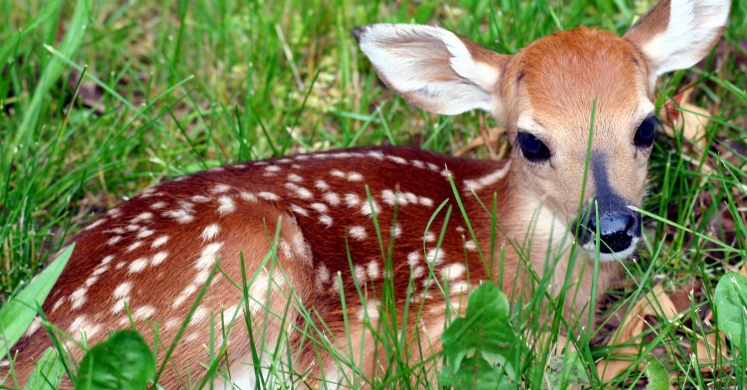Blog

#bioPGH Blog: Spring Baby Boom!
 A resource of Biophilia: Pittsburgh, #bioPGH is a weekly blog and social media series that aims to encourage both children and adults to reconnect with nature and enjoy what each of our distinctive seasons has to offer.
A resource of Biophilia: Pittsburgh, #bioPGH is a weekly blog and social media series that aims to encourage both children and adults to reconnect with nature and enjoy what each of our distinctive seasons has to offer.
The spring “baby boom” of the forest is in full swing, and there is an assortment of young wild ones out there exploring their own new little worlds. Have you ever noticed, though, that some animal babies are born rather helpless while others become independent very quickly? Or have you noticed that some animals produce hundreds of potential offspring (eggs) while others produce very few offspring and invest a significant amount time and energy raising those offspring? Let’s check out a few different strategies behind baby-raising biology!
A major factor behind raising wild babies is the trade-off between the level of parental care and number of offspring. Laying eggs, giving birth, and taking care of babies are all very energetically expensive activities for parents. Thus, in nature, there is a general spectrum ranging from a high number of offspring accompanied by little or no parental care to a low number of offspring with a high level of parental care. As you might imagine, the survival rates of offspring range widely between these two different strategies, so what are the advantages or downsides to each?
First, let’s look at those large broods with little parental care (also called r-strategists, if you’re interested in a deeper dive.) If you think about amphibians, for example, you will often see frogs or salamanders lay huge egg masses with numerous potential offspring – wood frogs can lay up to 3000 eggs in a single season, yet there is often little or no parental care after egg-laying. Those little eggs and the ensuing larvae and tadpoles are generally on their own. To increase survival odds, r-strategists’ offspring are usually precocial; they grow quickly and are capable of managing their own needs early on. Still, most offspring in this scenario don’t survive to adulthood (in the case of some amphibians, that survival rate can be less than one percent depending on the species), but each brood started with so many eggs, it’s a good bet that at least a few from that season will survive to become adults. Laying so many eggs is energetically costly to the female, but after that, her work is done.
On the other end of the spectrum, we can look at animals that have few offspring during their breeding season but provide a high level of parental care (also called K-strategists). Babies in this category are more likely to be born relatively helpless (altricial), and grow slowly under the watchful eyes of parents. Elephants are a classic example of K-strategists; mothers invest several years of parental care into each calf, the calves grow very slowly – not even reaching reproductive age themselves often until their teens—and mothers will typically not have another calf for 3-8 years. This is an incredible parental investment over the long term, but the outcome is a much higher survival rate for individual offspring, ranging somewhere around 70% for the first year of life.
Of course, nature rarely operates in absolutes, and there are plenty of examples of animals that don’t quite fit this spectrum tidily. Or they fit it in unusual ways, like jacana birds, where females lay many eggs with multiple males over a season, and the males offer the parental care! Either way, animal parents have their work cut out for them. There is either an incredible energy cost up front, or a long, steady energetic investment.
There is one very important way that we humans can help wild parents out, though; and counter-intuitively, it often means leaving the babies alone when we our first thought is that they need help. The delightfully sassy X (Twitter) account of the Oklahoma Department of Wildlife Conservation says it best:
it's another lovely spring day to REMIND YOU DELINQUENTS TO STOP "RESCUING" BABY ANIMALS. THEIR MOMS ARE MOST LIKELY NEARBY - SO MIND YOUR BUSINESS.
— Oklahoma Department of Wildlife Conservation (@OKWildlifeDept) April 26, 2024
FAWNS, DROP EM'.
BIRDS, LEAVE EM'.
RACCOONS, DON'T WORRY ABOUT IT.
FOXES?! -SWIPER NO SWIPING.
ARMADILLO?¿? ARMADILL-NO.
What should you do if you find a baby animal that needs help? Well, most importantly, be sure that the baby actually needs help before getting involved. Deer, for example, are often falsely identified as “orphaned” because of their natural behavior – mama will leave a fawn alone for much of the day to avoid drawing attention to the baby. This is often misinterpreted as “abandoned,” but the babies are actually just fine. If you do see a fawn two days in a row in the same spot, with no visit from an adult at the twilight hours, then you can call a wildlife rescue and see what they think; but more often than not, fawns don’t need our intervention. Similarly, if you see a young bird with scruffy feathers bopping around on the ground, he is also probably a new fledge; and this is part of the learning process. (However, if you find a tiny, featherless bird that has fallen out of a nest, as long as it isn’t injured, the baby’s chance is to be put back in its nest the parents to take care of it.) If you find a baby animal that truly does need help, one place you can call is Humane Animal Rescue of Pittsburgh in Verona. They have a network of volunteers that help them through this baby booming time of year!
Photo Credits: Cover, Forest Wander CC-BY-SA-3.0-US;

